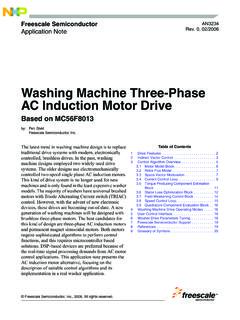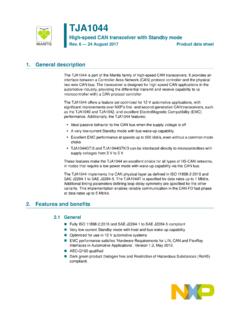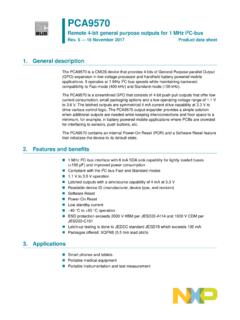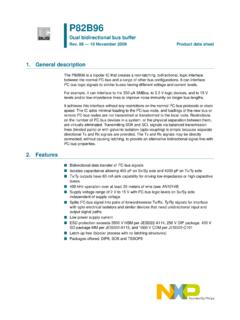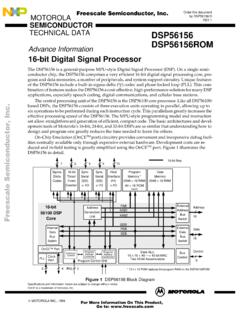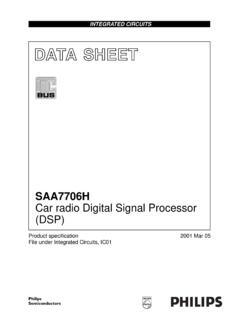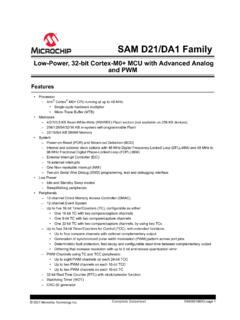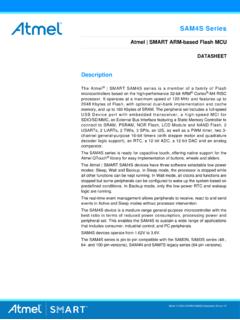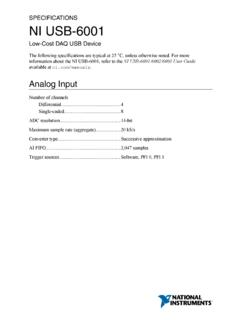Transcription of Features of the FlexTimer Module - NXP
1 2015 Freescale Semiconductor, Inc. All rights reserved. Features of the FlexTimer Module 1. Introduction The application note introduces multiple Features of the FlexTimer Module (FTM) and provides corresponding code for each feature , along with a waveform or a snapshot of the oscilloscope. While FTM is used in both the Kinetis and Vybrid families, this application note focuses on Kinetis only. FTM is available for all of the Kinetis K series. FTM is an enhanced version of the Timer/PWM Module (TPM) of HCS08 with new Features . FTM can: function as the Timer and Pulse Width Modulation (PWM) signal generator, generate at most eight PWM signals for each FTM Module , and generate edge-aligned PWM signals, center-aligned PWM signals, and phase-shift PWM signals. External/internal fault signals can disable PWM output signal.
2 The PWM Module can trigger ADC directly or through the PDB Module . FTM can generate four pairs of complementary PWM signal for edge-aligned, center-aligned, and phase shift PWM signals. FTM also has masking, inverting, and software controlling function for BLDC motor control application. The Features described in this application note are applicable for BLDC/ACIM/PMSM/SR motor control or switch mode power supply applications. Freescale Semiconductor, Inc. Document Number: AN5142 Application Notes Rev. 0 , 06/2015 Contents 1. Introduction .. 1 2. FTM description .. 2 3. PWM Features .. 4 Edge-aligned PWM mode .. 4 Center-aligned PWM mode .. 6 Complementary PWM signal .. 7 Phase-shift PWM signal (Combined PWM signals or Asymmetric PWM signal) .. 8 Divider .. 10 Generating a fixed cycle time interrupt.
3 10 FTM triggering ADC .. 11 Single-edge capture mode .. 14 Dual-edge capture mode .. 15 Quadrature decoder mode .. 17 Updating the FTM 19 Masking, inverting, and software controlling Features ..26 Fault signal disabling PWM output signals .. 27 Multiple FTM synchronization .. 29 FTM channel initial logic .. 32 PWM resolution .. 32 Appendix A. Pin assignment code .. 34 4. Revision history .. 35 FTM description Features of the FlexTimer Module , Rev. 0, 06/2015 2 Freescale Semiconductor, Inc. When FTM functions as a timer it can generate fixed cycle time interrupt, generate divided signal, and can count the Encoder signal with 90 degree shift. It has a capture function, which is used to detect and get Hall signal logic in motor control application. The capture function also helps in measuring the duty cycle or the period of external signal.
4 The code is developed in CodeWarrior for Microcontroller and TWR-K40x256 Tower board. 2. FTM description Typically, one Kinetis K family processor has two or three FTM modules. FTM with eight channels can generate a PWM signal to control a motor. One of the FTMs can receive Encoder signals, can receive Hall signals, and the third can generate fixed cycle time interrupt. The FTM0 in general has four pairs or eight channels CH0/CH1, CH2/CH3, CH4/CH5, and CH6/CH7. All the channel pins can output PWM signals and can also be input pins to get capture signals. The FTM1 has dedicated Phase A and Phase B signal input pins FTM1_QD_PHA/FTM1_QD_PHB, which can accept encoder sensor output signals. The Phase A and Phase B signals have 90 degree phase shift. For example, the Kinetis K40 family has three FTM modules: FTM0, FTM1, and FTM2.
5 FTM1 is a full function Module , which has capture function to detect and get Hall signal, generate capture interrupt, and can output PWM signals. Each FTM supports fault function. The fault signals can be from internal Module output for example comparator or external pins. The fault signal can disable PWM signals automatically so that the logic of PWM signal pins can be high or low, which can consequently disable power device in a control system. When the fault signal disappears, the PWM signal can recover automatically or manually. FTM description Features of the FlexTimer Module , Rev. 0, 06/2015 Freescale Semiconductor, Inc. 3 Figure 1. FTM block diagram PWM Features Features of the FlexTimer Module , Rev. 0, 06/2015 4 Freescale Semiconductor, Inc. Figure 1 is the FTM block diagram.
6 There are several clock sources which can drive the FTM Module . Prescaler is the internal clock divider. The FTM counter is reloaded from the FTM_CNTIN register. The FTM counter counts the clock source from FTM_CNTIN to the FTM_MOD register. During the process, the FTM channel pin can change its logic when the FTM counter reaches to FTM_CnV, which is a fundamental mechanism to generate PWM signal. FTM can be either a timer or PWM signal generator. The FTM_CnSC register determines the modes of the FTM. Table 1. FTM mode setting and capture edge level selection DECAPEN COMBINE CPWMS MSnB:MSnA ELSnB:ELSnA Mode Configuration 0 0 0 0 1 Input capture Capture on Rising Edge Only 10 Capture on Falling Edge Only 11 Capture on Rising or Falling Edge 1 1 Output compare Toggle Output on match 10 Clear Output on match 11 Set Output on match 1X 10 Edge-aligned PWM High-true pulses (clear Output on match) X1 Low-true pulses (set Output on match) 1 XX 10 Center-aligned PWM High-true pulses (clear Output on match-up) X1 Low-true pulses (set Output on match-up) 1 0 XX 10 Combine PWM High-true pulses (set on channel (n) match, and clear on channel (n+1) match) X1 Low-true pulses (clear on channel (n) match, and set on channel (n+1) match) 3.
7 PWM Features Edge-aligned PWM mode In edge-aligned PWM mode, the FTM counter counts up from the FTM_CNTIN value to the FTM_MOD value. All FTM channels signals align at the edge when the FTM counter changes from the MOD value to the CNTIN value. The Edge-aligned mode is selected when: (QUADEN = 0), (DECAPEN = 0), (COMBINE = 0), (CPWMS = 0), and (MSnB = 1) The edge-aligned PWM period is determined by (MOD CNTIN + 0x0001) and the pulse width or the duty cycle is determined by (CnV CNTIN) or (MOD-CNTIN-CnV) dependent on ELSnB:ELSnA bits setting. PWM Features Features of the FlexTimer Module , Rev. 0, 06/2015 Freescale Semiconductor, Inc. 5 Example 1. PWM source code in the edge-aligned mode void PWMO utput_EdgeAlignment(void) { SIM_SCGC6|=0x03000000; //enable FTM0 and FTM0 Module clock FTM0_CONF=0xC0; //set up BDM in 11 FTM0_FMS=0x00; //clear the WPEN so that WPDIS is set in FTM0_MODE register FTM0_MODE|=0x05; //enable write the FTM CnV register FTM0_MOD=1000; FTM0_C0SC=0x28; //edge-alignment, PWM initial state is High, becomes low //after match FTM0_C1SC=0x28; FTM0_COMBINE=0x02; //complementary mode for CH0&CH1 of FTM0 FTM0_COMBINE|=0x10; //dead timer insertion enabled in complementary mode for //CH0&CH1 of FTM0 FTM0_C1V=500; FTM0_C0V=500; FTM0_C2SC=0x28; FTM0_C3SC=0x28; FTM0_COMBINE|=0x0200; FTM0_COMBINE|=0x1000; FTM0_DEADTIME=0x00; FTM0_C3V=250; FTM0_C2V=250; FTM0_CNTIN=0x00; FTM0_SC=0x08.}
8 //PWM edge_alignment, system clock driving, dividing by 1 } Figure 2. Waveform of the PWM signal with the edge-aligned mode In Figure 2, the CH1 and CH2 channel signals on the oscilloscope are the FTM0_CH0 and FTM0_CH1 signals. The CH3 and CH4 channels signals on oscilloscope are the FTM0_CH2 and FTM0_CH3 signals. The waveform shows that the FTM0_CH0/FTM_CH1 are complementary signals, the PWM Features Features of the FlexTimer Module , Rev. 0, 06/2015 6 Freescale Semiconductor, Inc. FTM0_CH2 and FTM0_CH3 are complementary signals, and the rising edge of FTM_CH0 and FTM0_CH2 signals is aligned. The FTM0 works in edge-alignment mode. NOTE In Figure 2, CH1 is Yellow channel , CH2 is Cyan channel , CH3 is pink channel , and CH4 is blue channel . Center-aligned PWM mode In center-aligned PWM mode, the FTM counter counts up from FTM_CNTIN to FTM_MOD and then counts down from FTM_MOD to FTM_CTNIN.
9 All FTM channels signals align at the point when the FTM counter reaches up to FTM_MOD value. The center-aligned mode is selected when (QUADEN = 0), (DECAPEN = 0), (COMBINE= 0), and (CPWMS = 1). Example 2. The PWM source code in the center-aligned mode void PWMO utput_CenterAlignment(void) { SIM_SCGC6|=0x03000000; //enable FTM0 and FTM0 Module clock SIM_SCGC5=SIM_SCGC5|0x3E00; //enable port A/B/C/D/E clock FTM0_CONF=0xC0; //set up BDM in 11 FTM0_FMS=0x00; //clear the WPEN so that WPDIS is set in FTM0_MODE reg FTM0_MODE|=0x05; //enable write the FTM CnV register FTM0_MOD=1000; FTM0_C0SC=0x28; ////center-alignment, PWM begins with High FTM0_C1SC=0x28; //PWM waveform is high-low-high FTM0_COMBINE=0x02; //complementary mode for CH0&CH1 of FTM0 FTM0_COMBINE|=0x10; // dead timer insertion enabled in complementary mode for //CH0&CH1 of FTM0 FTM0_DEADTIME=0x1F; //dead time is 16 system clock cycles FTM0_C1V=500; FTM0_C0V=500; FTM0_CNTIN=0x00; FTM0_C2SC=0x28; FTM0_C3SC=0x28.}
10 FTM0_COMBINE|=0x0200; FTM0_COMBINE|=0x1000; FTM0_C3V=250; FTM0_C2V=250; FTM0_SC=0x68; } PWM Features Features of the FlexTimer Module , Rev. 0, 06/2015 Freescale Semiconductor, Inc. 7 Figure 3. Waveform of the PWM signals with the center-alignment mode In Figure 3, CH1 and CH2 signals on the oscilloscope are the FTM0_CH0 and FTM0_CH1 signals. The CH3 and CH4 signals on the oscilloscope are the FTM0_CH2 and FTM0_CH3. The waveform shows that the FTM0_CH0/FTM_CH1 are complementary signals. The FTM0_CH2 and FTM0_CH3 are complementary signals. The center of FTM_CH0 and FTM0_CH2 signals are aligned, specifically, the center of Low logic of both FTM_CH0 and FTM0_CH2 signals are aligned due to the fact that FTM signal waveform mode is High-Low-High. The FTM0 works in the center-alignment mode, while a dead-time is inserted, which means that there is a low time between low edge of FTM0_CH0 and rising edge of FTM_CH1.

